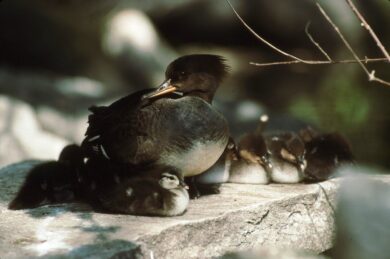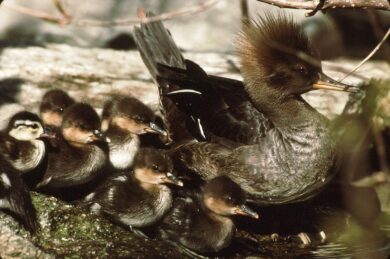Egg dumping can be a common occurrence among cavity-nesting waterfowl like Wood Ducks, Hooded Mergansers, and Common Mergansers. This happens when a female of one species (often a first-year breeder) lays her eggs in a neighbor’s nest (usually of the same species). Technically called intraspecific brood parasitism, it has been documented in more than 200 species, most of them waterfowl or songbirds. Among Wood Ducks it is most prevalent when nest boxes are placed in conspicuous locations and in close proximity to each other. Egg dumping often results in exceedingly large clutches, often too large for the female to successfully incubate. An average Wood Duck clutch is about 10 eggs, but that swells to 14 eggs in highly visible nest boxes, and may reach as many as 30-40 eggs!

A female Hooded Merganser with her brood of seven merganser chicks and one Wood Duck, the result of intraspecific egg dumping, rest on a rock at the water’s edge. © Steve Faccio
Less common, however, is interspecific egg dumping, in which a female of one species lays eggs in the nest of another species. I encountered this unusual occurrence some years ago while photographing waterfowl from a floating blind on a shallow four-acre pond that contained three Wood Duck boxes. I knew from previous visits that two of the boxes were being used by Wood Ducks, but one morning I found that the third box must have contained a Hooded Merganser nest, as the female “hoodie” was being closely followed by eight fluffy, mahogany-colored merganser chicks. When the female dove to feed, I was surprised to see seven of the chicks follow suit and disappear underwater. That’s when I realized that the eighth chick, which was still floating on the surface, was a Wood Duck, undoubtedly the product of egg dumping. The lone duckling—easily recognizable by its white face and dark eye stripe—seemed somewhat alarmed whenever its “siblings” followed their mother underwater, swimming in circles until the mergansers reappeared and the brood assumed their place, single file, behind their mother. When the group paddled over to a large rock for a rest I finally got the opportunity to photograph the entire brood, as they huddled close to the female, dozing on and off in the morning sun.

The same group of ducks gets ready to return to the water, the Wood Duck brings up the rear. © Steve Faccio
I followed the brood for a couple of weeks, before the family “disappeared,” presumably moving to a large, marshy pond nearby, so I was unable to confirm if the lone Wood Duck successfully fledged alongside its diving nest mates.

astute observation, and great photos!
What a great observation and photo!